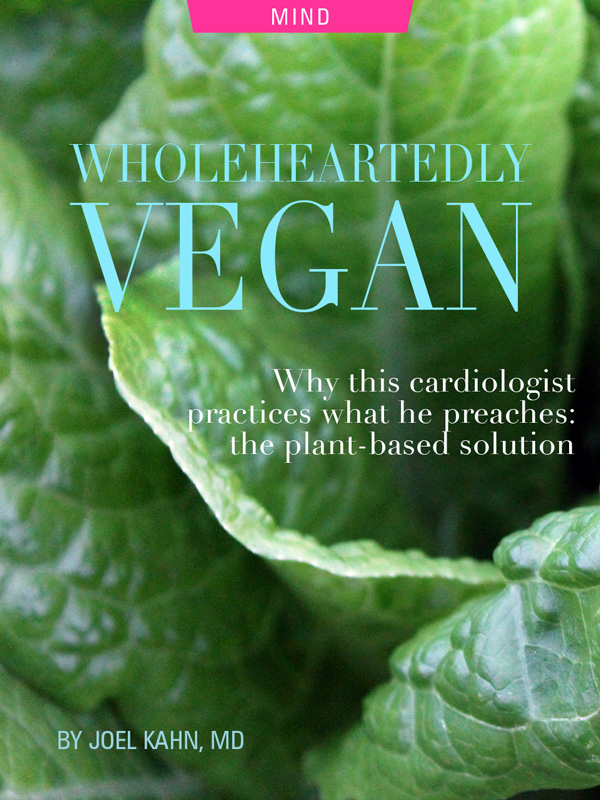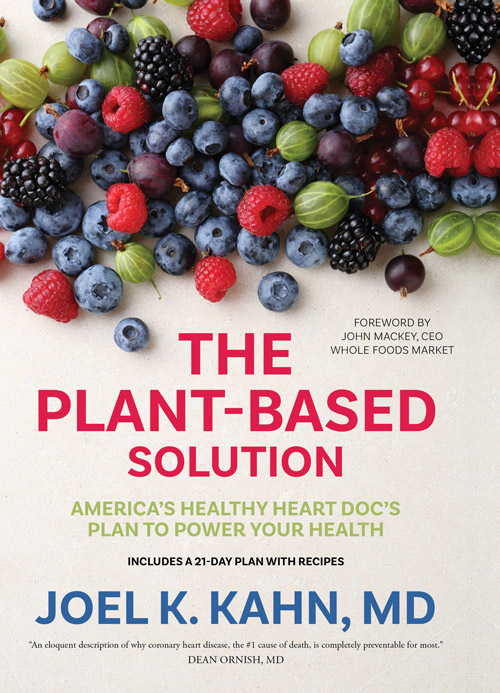
How one cardiologist puts his heart where his plate is, transforming his own practice, health and plant-based mission
—
I was raised in a home that observed kosher dietary laws of the Jewish faith. The meat we purchased — and yes there was meat — was bought at a special kosher butcher shop. We never combined milk and meat at meals. And there were some foods, like pork and shellfish, which were never in the house, as they are always prohibited.
This experience was a blessing in many respects because it elevated food to something that required mindfulness. I learned to pause before eating to consider if the content of my plate was acceptable to my tradition.
Food mindfulness is a key to appreciating the miracle of health, the power we hold to choose wisely or poorly, and in staying the course on a dietary program that is different from the norm.
If you have no food rules and can eat anything made anywhere, there are literally tens of thousands of choices to consider, and it can tire you out.
By some estimates, there may be over 200 decisions daily on food choices, and it can be a strain. If you grew up eating kosher as I did — or eating only vegetables, fruits, legumes, nuts, and seeds as I do now — the “decision fatigue” decreases enormously, for eggs, meat hamburgers, dairy ice cream, and BLTs are never a consideration. It is actually easier to choose from a shorter list. Think of a list with five great wines versus 500 choices. Which is easier to utilize on a daily basis when you are rushed and managing your busy life?
At age eighteen I was accepted into a combined premedical/medical program and entered the University of Michigan in Ann Arbor with my long-time girlfriend, Karen, who was accepted into the nursing school at the same university. On the first day of classes I walked into the dormitory cafeteria with Karen, and we looked around. Only the salad bar looked appealing, and it also met the kosher rules we wanted to honor, so we became vegetarians. That decision has remained in place for forty years, as well as the decision to stay together — we have been married now for over thirty-six years.
The transition from college vegetarian to vegan happened after we both read the book Diet for a New America, which laid out the reasons a plant-based diet was ideal for health, kindness, and the planet. Around that time, my parents began visiting the Pritikin Longevity Center in Miami, where my mother, quite an accomplished cook, learned the nuances of plant-based cooking that was also very low in salt. My plant-based commitment was sealed when I began my medical practice in Ann Arbor as a staff cardiologist and catheterization laboratory attending physician. I had gained advanced skills during my cardiology training in balloon angioplasty and so was off and running on July 1, 1990, my first day at a busy practice. Plants powered me. All of that lasted only three weeks because my life changed on July 21, 1990.
I was going through my mail late at night and reading the medical journals that had arrived (this was before digital editions). In a prestigious British journal called The Lancet was a report on patients with advanced heart disease treated with either standard therapy or a program emphasizing a plant-based diet low in fat along with walking, social support, and stress management. I did not know of the lead author, Dean Ornish, MD, but I recognized many of the other authors as leading academic physicians admired worldwide.
The report, which looked at baseline and follow-up cardiac catheterization, my specialty, claimed that blocked heart arteries became better, or reversed in severity, during a plant-based diet and lifestyle program.
This had never been reported before, and I was dumbfounded but excited. I read the report over and over and was impressed by its important and potential impact in my practice. While I did not stop performing advanced catheterization procedures that day, I did start teaching my patients that the lessons from the Lifestyle Heart Trial should be adopted in their own lives to prevent further blockages and procedures. Today, over twenty-five years later, that is my only focus: teaching the early detection, prevention, and reversal of the number one killer of men and women in the world, heart disease, along with other serious medical challenges like adult diabetes, obesity, hypertension, autoimmune disorders, and even some cancers.
Today, I have largely retired the balloons and stents and offer heart disease treatment and reversal programs. I use plant-based nutrition as the foundation of my therapy. My interest in nutrition and disease prevention grew to occupy more and more of my time and practice. Because of that, I took two steps that have had a major impact on the Detroit community and even nationwide.
The First Step: A Plant-Based Nutrition Support Group
To help support the patients I had been teaching the values of a plant diet, I co-founded a plant-based nutrition support group in Detroit that has now grown to over 4,000 members. Our monthly meetings draw hundreds of attendees and provide information from noted speakers local and distant, a forum for answering questions (e.g. why no added oils?, how do you get your protein?), and local friendships/community.
The Next Step: A Whole-Food, Plant-Based Restaurant Concept
I wanted to do more to help people interested in eating out healthfully. About three years ago my oldest son Daniel and I decided to tackle this project using his MBA and interest in vegan nutrition combined with my practice and public exposure. After reviewing some franchises and discussing options with several local restaurateurs, we decided to create our own concept without compromise. A small restaurant in Ferndale, Michigan came on the market, and we grabbed it at the end of 2014. We gutted the place and designed a kitchen specially designed for plant-based cooking. We equipped it with special ovens for producing gourmet oil-free vegan entrees and did not install any fryers. The owner of the store next door died suddenly so we decided to double our space with a lounge and large bar.

GreenSpace Café now seats well over 100 guests with patios in front and back when the weather permits. The seating can balloon to nearly 150 and offers a completely plant-based (vegan) gourmet menu. It’s a welcoming café with handcrafted foods featuring organic herbs and spices. We try as hard as possible to use only products that are certified organic or grown by local farmers we know are using organic practices. Our connections with local farmers are strong, and we design our menu based on their growing seasons and output. The menu has many items that are gluten- or soy-free, and we offer many entrees with no added oils, welcoming followers of Dr. Esselstyn, Dr. Ornish, and other leaders in the field of heart disease reversal. Of course, all offerings are dairy free.
We just celebrated our 2nd anniversary and most nights Daniel is joined by me and my wife Karen greeting guests. So many are first time plant diet eaters and are amazed by the beauty, quality and taste of foods without animal products. We calculated that in our first 2 years we served over 130,000 guests and a quarter of a million meals.
We have saved 47,000 animals from slaughter, saved 52, 000,000 gallons of water and over 1 million square feet of forest.
Although it has been hard work, when I see people of all ages and diets enjoying meals that are truly healthy and also friendly to animals and the environment, it is all worth it. For me, this is a dream come true. It’s been over 25 years since I performed my first angioplasty in practice and learned at the same time that healthy eating can reverse heart disease. Now I get to introduce new generations to delicious, beautiful food that also promotes real health. While I still direct my heart attack prevention center daily, GreenSpace Café is my lab for health and wellness that will keep generations away from the hospital.
You may also enjoy reading Eat Your Veggies: 11 Superfood Vegetables to Include in Your Diet by Austin Winder
